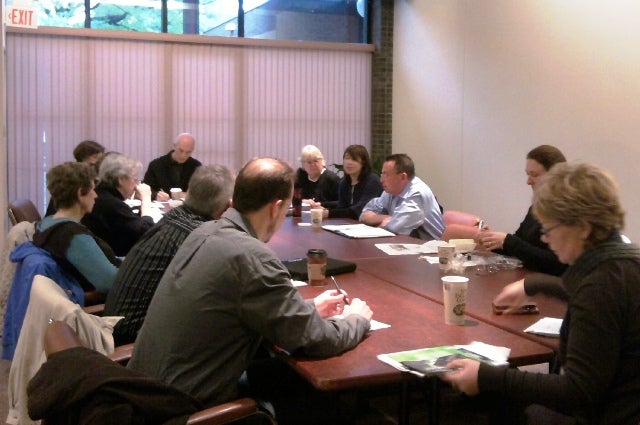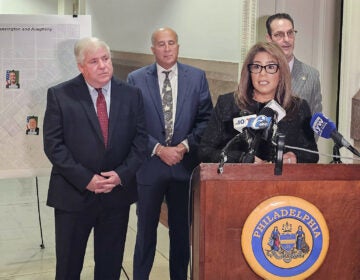CDAG holds report card on waterfront progress

Nov. 12
By Kellie Patrick Gates
For PlanPhilly
The Central Delaware Advocacy Group is working on a report card that will gauge the city’s progress in implementing the long-range plan for the Central Delaware Waterfront.
The report card was scheduled to be released at a Tuesday night meeting at which the Delaware River Waterfront Corporation introduced the five finalists competing to develop the Central Delaware Master Plan. The decision to hold the release was made at the last minute Tuesday after city and DRWC officials and others said they felt blindsided by the release and content of the document, which lists the goals of the Central Delaware Action Plan and gives the city a letter grade on each. There was at least one F.
CDAG member Joe Schiavo – who wrote the document with email input from some of his colleagues – and CDAG Chairman Steven Weixler said the grade was not meant to say the city had failed, only that much work remains to be done to reach that particular goal.
That is understandable considering the city is just one year in to a multi-year plan, they said.
At Thursday’s CDAG meeting, DRWC master planning manager Sarah Thorp said no one wants to edit or control the document, but that CDAG should have given everyone a heads-up.
“I was really surprised,” said Thorp, who attended the CDAG meeting to discuss the recent Master Plan event with board members. She said her boss – DRWC President Tom Corcoran – was surprised, too. “We see CDAG as a really close partner,” she said. “It was really disappointing to be surprised by something like that” at an important public event.
It’s “really valuable” for CDAG to track the city’s progress on its riverfront goals, Thorp said.
The original document, which is now considered a draft, is not being released.
Board members said Thursday that it is a good idea to give a heads-up before the document is released. But they do not want the content to be swayed by any official reaction.
https://www.youtube.com/watch?v=1ZwqEz0ywn4
“I definitely want to know what you think, and I want to know what the DRWC thinks,” said CDAG Board Member Caryn Hunt. “But I also believe that as important as it is to work in partnership with DRWC – and I think that it is crucial – I think we have an obligation to, you know, hold up a yardstick in terms of the Civic Vision. That’s the purpose of the group. That’s our mission statement.”
The CDAG report card on the Civic Vision Action Plan evolved out of a different task. At the group’s October retreat, Schiavo volunteered to put together a list of CDAG’s accomplishments, to be used in a brochure about the group, which was created to advocate for the Central Delaware plan. As he compiled that list, he said after Thursday’s meeting, it became clear there was a second list of accomplishments, and things to be accomplished, that pertained to the city, Schiavo said. He compiled that list and emailed it to the other board members for input. About six participated in the electronic dialogue over five days, he said. Schiavo was also assisted by Michael Greenle, who represents PennPraxis at CDAG meetings. Praxis doesn’t have a board seat, but advises CDAG.
Schiavo said Tuesday’s meet-the-finalists event seemed the perfect place for CDAG to release the report card, because many people who are interested in the riverfront would be in attendance.
Weixler said after the CDAG meeting that he did not realize this was the plan until Monday. He said he would have preferred that the entire CDAG board discuss the report card in person before the release, but “I agreed to go with Joe’s judgment.”
Just before Tuesday’s master plan finalist event, Weixler said he heard comments similar to Thorp’s from Corcoran, Deputy Mayor for Planning and Commerce Alan Greenberger (who is also executive director of the Planning Commission) and first district Councilman Frank DiCicco’s policy chief, Brian Abernathy. “I made the decision to hold off,” Weixler said. None of those who complained about the report card’s potential release wanted to edit it, Weixler said. They wanted advanced notice.
Board Member Jeff Rush said he felt like CDAG had dodged a bullet.
Yet, even as board members said they felt anything of this magnitude needed to be discussed by the full board, in person, before launch, they praised Schiavo for the work he did. Some board members said they had not seen the document, but those who did said the text was accurate and on-point. Some said a CDAG report card could become an important, annual document.
Schiavo said in hind site, he is glad things worked out as they did. “I agree at this point” that the A,B,C,D,F grading system is “harsh,” he said.
CDAG voted to review and refine the document at its December retreat. No vote was taken on whether the document will be released eventually, but the majority of members present Thursday seemed to want that to happen. Discussion centered on not changing the text much, but on using a rating system that would gauge what progress has been made to date on each goal, perhaps by using a 1 to 10 scale.
https://www.youtube.com/watch?v=aRnYy1xswcQ
Schiavo said he would also like to add introductory text that explains the riverfront goals are expected to take many years.
The report card discussion came at the end of the meeting. During the first part, Thorp gave CDAG a run-down of what Tuesday’s finalist event had accomplished, and CDAG gave her suggestions on how future public sessions could be improved.
Thorp told the CDAG board that while DRWC wanted to hear public comment Tuesday, the decision concerning which firm to hire rests with the DRWC Planning Committee, and that decision will be made in private.
A public selection would hamper the process, she said, because each team would know what the other team is proposing, especially in terms of cost. Interviews were conducted with the finalists in late October, she said – when teams came prepared to answer specific questions. Some of this has been shared with the public, but not all. The planning committee hopes to make its selection within the next week or so, Thorp said. A recommendation will be made to the full board at its Nov. 23 meeting, which is open to the public.
https://www.youtube.com/watch?v=koJqMci1A3Y
CDAG member Matt Ruben asked if the DRWC has development goals related to the 100 or so publically owned acres that the DRWC controls. Thorp said that probably all of this land would be part of the “early action” projects in the Master Plan. About 97 percent of the land is privately owned, Thorp said, and that means it will be more challenging to see it developed according to the plan guidelines. That, she said, will take a combination of outreach and incentives for private land owners.
For the public lands, the DRWC is going to have to find a way to raise money for both the improvements and upkeep, she said, so economics will be a key portion of the master plan consultants’ work.
Ruben and others also asked about the public input part of the process. Thorp said that the consultant will have to have at least three public input sessions.
https://www.youtube.com/watch?v=6hNvPgzVRcA
CDAG member Laura Lanza said if the DRWC wants “authentic” public engagement, they will sometimes have to go to public places and events to get it, and hold events on weekends, when more working people are available.
Lanza said the Tuesday night meeting was good, but the majority of the audience – estimated at over 200 people – seemed to be “city employees and planners.”
Hunt said that the question and answer period at the end of the formal presentation was far too short. “Lots of questions did not get answered, and I personally feel like that was a huge flaw,” she said.
Thorp said that the Q & A was purposefully kept short, and that questions were directed not to the consultants, but to Greenberger, Corcoran, and Planning Chair Marilyn Jordan Taylor, who is dean of the Penn School of Design. Thorp re-iterated that negotiations can’t be held in public if the DRWC is to find the best team and get the best price. She said finalists are not normally introduced to the public.
https://www.youtube.com/watch?v=3Lp0xQAl3Fs
Thorp also said that the DRWC has much more information about each proposal than what was discussed Tuesday night, and the event organizers did not want anyone in the public to judge the consultants solely on information they received, or the answer to a question.
Lanza said that tactic should have been explained at the beginning of the session. Hunt said the audience had many more questions for the DRWC.
https://www.youtube.com/watch?v=5IaZlP3kRfo
CDAG member Rene Goodwin suggested that when portions of the vision are going to become reality, the civic associations in that area should be notified. Most Pennsport residents at their civic meeting did not know that a portion of the multi-purpose riverfront trail had opened in their neighborhood, she said.
Thorp said the point was well taken, but the reason no notice of the trail was given is that it is not officially open, because negotiations are not yet complete with some of the private landowners. The issue, Thorp said, relates to liability. Goodwin said that people are already using the trail, so perhaps an effort should be made to announce that the trail isn’t really open yet. Thorp said the issues are expected to be resolved in short order.
https://www.youtube.com/watch?v=9HRcQ6PDmhw
https://www.youtube.com/watch?v=yRSzZ5TFprg
Contact the reporter at kelliespatrick@gmail.com
WHYY is your source for fact-based, in-depth journalism and information. As a nonprofit organization, we rely on financial support from readers like you. Please give today.




